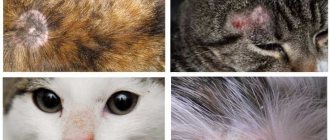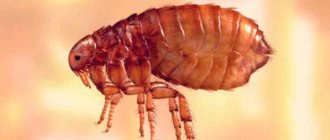Let's try to analyze the main reasons why a cat can constantly itch and lick itself, but it does not have fleas and, perhaps, never had any. What, then, is extremely troubling to your pet?
Cats are recognized as naturally clean people; they regularly take care of their fur, diligently brushing it and licking it thoroughly. This is the instinct of a predator, inherited by our pets from predatory ancestors. Therefore, catching a cat washing itself is a common occurrence.
But if a cat often licks and scratches beyond measure, this always causes justified fears among loving, attentive owners - it means that something wrong has happened to their pet. This restless behavior is a consequence of your pet being constantly itchy, but not necessarily due to fleas.
Various factors can contribute to the occurrence of severe itching. Therefore, a symptom such as scratching and licking should be a good reason to search for the cause and eliminate it as quickly as possible. Most likely, you will need a visit to the veterinarian, where it will be found out exactly why the cat is itching, and your beauty will receive adequate treatment.
With prolonged intense scratching, wounds, bald spots, irritation and damage to the skin occur, turning into an open gate for new infections, and your cat is at risk of secondary infection, which is even more difficult to fight. This is why it is so important to address the cause of the itching early so that your cat can recover faster.
Causes of itching in cats
Fleas on an animal
The most common probable cause of your cat itching all the time is a flea attack. But if you are sure that there are no fleas at the moment, then know that an allergy to a flea bite in some four-legged animals can last up to 6 weeks. Therefore, it is not surprising that the cat continues to worry all this time, although the fleas have been gone for a long time.
But when the cat is domestic, does not leave the apartment and it really does not have fleas, then the most likely reasons for constantly scratching and licking its fur may be the following problems:
- helminth infection;
- skin and other bacterial inflammations;
- ringworm and other fungal infections;
- lice, lice, mites and other external parasites;
- allergic manifestations of various origins;
- psychogenic factors;
- hormonal disorders.
Below we will take a closer look at each of the most common reasons why, in the absence of fleas, a cat is worried about severe itching, but in reality there are many more of them.
Veterinarian advice
It is no secret that many parasites and viruses are transmitted from one animal to another, through the hands of people, but you should not be afraid and limit the freedom of a cat. Of course, there is no need to throw your pet into a pack of stray cats, but letting it out for a walk on the balcony or in the country is quite possible. Like any animal, cats also need fresh air and sun. It is enough just to keep the animal clean and carry out timely antiparasitic treatment.
Do not forget about a proper and balanced diet, which is also the key to your pet’s health. If he has a strong immune system, then no infection will be scary to him. Do not feed prohibited foods, sweets, salty and smoked foods.
All this can cause or provoke the occurrence of food allergies. Pay attention to when your pet licks.
And finally, the last piece of advice is love and affection. Remember that your cat is a living creature that needs your care and attention. A change of owner or a change in your behavior can cause stress in your pet. And stress, as you know, is the first step to illness. If you want to pet an animal, but it is nervous and wags its tail, it is better to leave it alone, do not squeeze or pick it up without the desire of the pet itself. Remember that he also has the right to peace and rest.
Sorry, there are no surveys available at this time.
[custom_ads_shortcode1]
Infection with helminths as a cause of itching
Helminth
Helminths, if not regularly combated, can significantly annoy your pet, undermining its health from the inside.
The consequences of the vital activity and reproduction of worms in a cat’s body can be many troubles that bring suffering to your pet no less than fleas:
- The cat feels discomfort in the anus, itches and licks it;
- her stool and digestion are disrupted, her appetite is distorted;
- the coat becomes dull and the skin becomes dry and flaky;
- eyes turn sour;
- behavior becomes abnormal: apathetic or, on the contrary, excited.
Even the smallest kitten can suffer from worms if it is infected from its mother.
To prevent infection with worms, regularly clean with anti-helminth medications.
Experts' opinion
Despite the fact that an animal with its tongue hanging out looks cute and makes you smile, we must not forget about the possible threat to its health
First of all, you need to pay attention to any changes in your pet’s behavior.
First of all, this sign means complete trust and relaxation. If the animal is in a stuffy place and often sticks out its tongue, then it is worth moving it to a cooler room.
Most importantly, any symptoms that occur along with frequent tongue protrusion can signal that the animal is starting to get sick. Some diseases, such as rabies, can cause aggressive behavior in an animal that is dangerous to humans.
Before you start admiring your pet's new ability, you should show it to the veterinarian. There are many dangerous diseases that can be avoided if you just start treatment on time. The examination will not take much time, and you will be sure that the cat’s peculiarity does not cause harm, and you will continue to admire it.
Skin and other inflammations in cats caused by bacteria
Here we will touch only on those processes that provoke itching in different parts of the body and force the animal to scratch itself regularly.
Pyoderma
This is a severe bacterial infection of the superficial, or less often deeper, layer of the skin. The consequences of pyoderma are:
- the cat may go bald;
- become covered with pustules and crusts;
- the animal finds no peace, constantly itches furiously and meows.
Cats of all breeds are equally susceptible to infection, but the risk of complications is more often observed in animals with folds on the body, so the owners of such beauties have to be especially careful.
If the lesion has not affected the deeper layers and there are no complications, then recovery occurs quickly at home, but under veterinary supervision.
Ear infection
Symptoms of otitis media in a cat
Otitis in cats can provoke, in addition to severe pain and depression, a desire to scratch the sore ear with a paw.
The need to eliminate itching by frequent scratching results in the appearance of wounds and cuts, because the cat’s claws are sharp! Complete or partial baldness around the affected ear is also possible.
Treatment depends on whether the otitis media is caused by ear mites or bacteria. Therefore, it is better to visit a veterinarian, he will do a scraping for analysis and prescribe the necessary type of treatment.
Diagnosis of the condition
An unpleasant sensation that causes a strong desire to scratch is itching. This condition in an animal is an obvious sign of skin damage. In veterinary medicine, there are 2 types of disorders:
- Localized type, when one or several places on the pet’s body begin to itch. Sometimes scratches appear only on the face, as well as on the neck and cheeks.
- Generalized type, which involves the appearance of sores on the entire body of the animal.
If you notice that your cat is itching a lot and drops of blood appear in the scratching areas, you need to contact a specialist at a veterinary clinic. To begin with, the pet is examined for the presence of blood-sucking parasites, which can cause severe stress in both couch potatoes and walking individuals. Scratch marks from bites are most often found on the chin, cheeks, neck, and tail. If fleas or ticks are not detected, then we are talking about other, more serious reasons.
After questioning the owner, the doctor will scrape the damaged area on the pet’s skin. Examination of the sample in the laboratory helps to identify the causative agent of the disease. Additional tests may also be ordered.
Once the exact disease is determined, the veterinarian prescribes treatment and gives additional recommendations on nutrition and care for the recovering patient.
Unfortunately, owners go to the veterinary clinic too late: when they discover severe wounds, bleeding scratches or bald patches on the pet’s body. This is the next stage of the pathology, which causes severe discomfort and can lead to severe infection. The duty of a good owner is to notice and respond to the problem in a timely manner.
Ringworm and other fungal skin infections in cats
Trichophytosis (ringworm)
Take a close look at the areas where your cat scratches most frequently. If there is no hair there, and the bald patch resembles a circle, then it is ringworm.
Important! The disease is caused by a fungal infection. Is contagious to people! Be sure to start treatment as soon as possible!
At home, lichen can be easily and quickly treated in cats, but in people infected from a sick cat, treatment is more difficult.
Dermatomycoses
Fungal and yeast infections of the skin and fur of cats lead to similar symptoms that greatly annoy your pet.
Not dangerous for people. They are treated with specific therapy, which is prescribed by a veterinarian after examination.
Prevention
Preventive measures boil down to following the following recommendations:
do not allow your pet to come into contact with stray animals;
use special means for the prevention of parasitic diseases (collars, sprays, drops, etc.);
Regularly comb the animal and monitor the condition of the skin and coat;
feed with good quality food and mixtures from trusted manufacturers;
Visit your veterinarian regularly for a clinical examination.
The owner should know that the pet’s close attention to its coat, constant licking, and combing the skin with its paws is not a harmless phenomenon. As a rule, such anxiety is caused by the development of the disease
Only a veterinarian can identify the cause, make a diagnosis and prescribe treatment for a pet.
- How to determine lichen in a cat, what it is and how... This form of the disease causes anxiety in the animal, burning and itching. ... To do this, you need to regularly monitor the condition of the skin. ... Why is a cat thin, reasons why a cat doesn’t... Read more
- Why does a cat's hair fall out, it comes out in clumps...
Key reasons why a cat's hair falls out. Fluffy and affectionate cats are a real decoration for any home. ... With allergic hair loss, the owner will also experience itching, redness of the skin... Read more - The cat scratched its ear until it bled: what to do if it itches...
Reasons for the animal's behavior. The reasons why a cat scratches its ears... A parasitic mite gnaws through the layers of the epidermis and violates the integrity of the skin. ... The animal has severe itching and restless behavior. Read more - Ringworm in a domestic cat: where could it come from?
The main reasons why lichen in a domestic cat can arise. ... injuries and microtraumas of the skin ... The disease is accompanied by itching. An infected animal often itches and behaves restlessly. Read more - How to treat lichen in a cat, what to smear and treat...
Lichen planus. It causes a malfunction of the immune system and is a non-contagious form. ... The cat is bothered by itching and scratches often. ... Violation of the integrity of the skin leads to the penetration of bacteria and... Read more
Lice, lice, mites and other external parasites that cause itching
These unpleasant “guests,” including fleas, are called ectoparasites. All of them provoke severe itching, flaking of the skin, and hair loss.
The cat is forced to literally scratch its skin, injuring local and large areas.
If treatment is not started in time, secondary inflammation, suppuration, sepsis and baldness may occur.
The most dangerous and difficult for cats are:
- ear scabies - a mite that settles in the external auditory canal;
- sarcoptic mange, which affects various parts of the cat's body;
- notoedrosis, localized mainly on the face.
The animal is experiencing serious suffering, so it is better to begin treatment as soon as possible.
Possible disease
Allergy
This is a common disease, but it is not immediately diagnosed. The main signs include: hair loss, dandruff, otitis media, unpleasant odor from the mouth and hair, scabies, sores, wet armpits. At the same time, the cat chews its paws, rubs its nose, and vigorously licks itself.
Causes of allergies:
- dust, mold, pollen;
- Food;
- flea remedies;
- medical supplies;
- hygiene products;
- infection;
- insect bites;
- reaction after vaccination;
- low-quality material (toys, bedding, drinking bowl);
- breed tendency.
When introducing a new product into the diet or skin and coat care products, it is necessary to monitor the pet's behavior. Food allergies manifest as inflammation around the head, anus, and ears. Vomiting and diarrhea occur.
Allergic manifestations that cause itching
The cause of an immune attack in the form of dermatitis can be many factors, so identifying the allergen is easier to do by exclusion.
Nutritional factor
The most common complaint is itching. Here the easiest way is to identify the “culprit” by eliminating one of the components from the diet one by one. It’s better to remember and analyze when the problem arose and what it might be related to. Perhaps it was a transition to a new food.
Contact factor
When the influence of food and all of the above reasons is excluded, and the cat continues to itch intensely, he may be allergic to pollen from indoor plants, dust, air freshener, washing powder or soap, or shampoo.
Drug factor
If your pet is currently or recently on medication or has had a vaccination, stop treatment and wait. Drug dermatitis will go away on its own.
What to do if treatment is unsuccessful?
With correctly prescribed therapy, the effect is noticeable from the first days: the animal itches less and the ulcers begin to dry out. If there is no improvement within 5-7 days, you should definitely visit a veterinary clinic.
Even if the veterinarian prescribed the drugs, but there is no result, contact us again. It also happens that an examination by another doctor or in another veterinary clinic helps.
The main thing is not to let things take their course and achieve improvements in the cat’s condition. Otherwise, you will have to treat not only the root cause, but also secondary infections.
Hormonal imbalances that cause scratching
In fact, there are few of them, but some are not so rare. Therefore, it is better to have an idea about them when analyzing the causes of excessive itching.
Thyroid dysfunction
Both hypothyroidism and hyperthyroidism cause baldness, dandruff, itching, and tangled fur in cats.
Cushing's syndrome
Disruption of the adrenal cortex in the direction of intensification. Provokes alopecia on the sides and back. The skin becomes thinner, loses elasticity and strength. Visible comedones appear.
Inflammatory processes that cause cats to itch
An obvious pathological factor that provokes constant itching of the skin in an animal is an active inflammatory process. It can be both local and systemic. The most well-known diseases in cats accompanied by an inflammatory process:
- Otitis. If this disease is present, the cat constantly scratches its ears and is very irritable because it suffers from severe pain. The solution to the problem will be the use of drugs that reduce the intensity of the inflammatory process in the designated location;
- Pyoderma. Pyoderma in animals is manifested by purulent inflammation of the skin provoked by coccal bacteria. The cat's epithelium is deeply affected and cannot be treated with local remedies: antibacterial therapy is required under the mandatory supervision of a veterinarian;
- Secondary bacterial infections. They occur after insufficient aseptic treatment of wounds, cuts, and surgical sutures. Treated with broad spectrum antibiotics.
Have you noticed that the cat licks its fur in an unusual way?
Sometimes the normal process of grooming becomes obsessive. This excessive licking is a signal that there is a problem.
Licking that causes excessive hairball regurgitation or even balding skin is abnormal. The skin is exposed to sunburn, hypothermia and other adverse environmental influences. Intact skin is resistant to infection. If a cat licks its fur to such an extent that it breaks the integrity of the skin with its rough tongue, infection may occur in these places. The infection, in turn, increases the intensity of licking. Thus, a vicious circle of “infection-licking” is formed. It can be broken only by identifying and eliminating the original cause. The owner can check for the presence of parasites (fleas, lice, etc.) in the cat's fur; in addition, consultation with a veterinarian is necessary.
If your cat licks its fur too often or for too long, do not ignore this fact. A cat can lick itself to such an extent that there is no hair left on the skin. Usually, owners notice that the cat licks its fur too often when bald spots appear on the stomach and other easily accessible places on the body. One sign of excessive licking is frequent regurgitation of hairballs. This means it's time to stop observing and start taking action. What to do if you decide that your cat pays more attention to licking its fur than necessary?
According to Doctor of Veterinary Medicine (DVM) Pamela Perry of Cornell University's Animal Behavior Clinic, the average cat spends 30 to 50 percent of its grooming time grooming. This is quite a lot, so owners do not pay attention to the problem until they notice significant hair loss or even skin damage.
Psychogenic factors
Cat owners underestimate the potential psychogenic causes of itching in an animal. The latter appear during periods of severe stress, for example, in the absence of the possibility of mating. In this case, the pet may not only constantly itch, but also mark its territory, behave aggressively, refuse to eat food, and tear furniture with its claws.
There are several ways to solve the problem:
- Organization of mating;
- Castration of an animal;
- Using special sedatives for cats.











